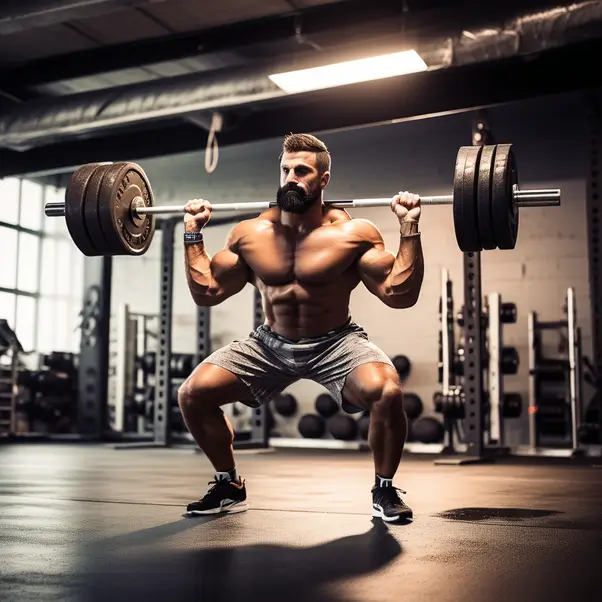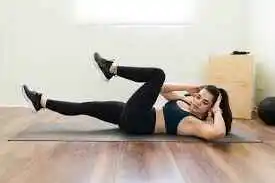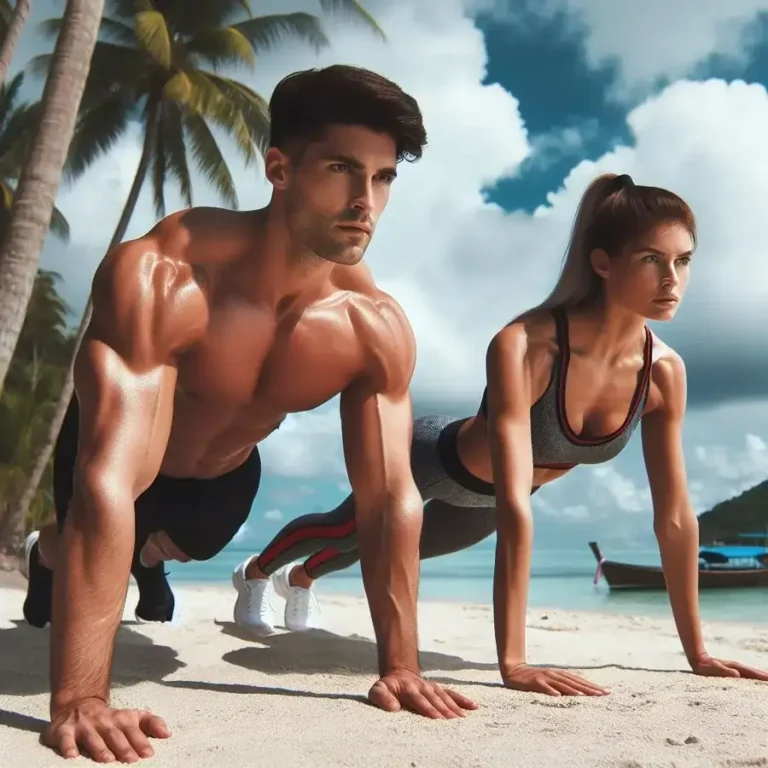Squat Exercise
What is squat exercise?
The squat is a fundamental exercise that plays a pivotal role in building strength, improving mobility, and enhancing overall fitness.
Squats are a dynamic strength training exercise that calls for the simultaneous use of multiple upper and lower body muscles.
Your ability to walk, climb stairs, bend, and lift heavy objects is aided by several of these muscles. They also assist you in carrying out sports-related tasks.
You may improve your exercise performance, lower your chance of injury, and maintain your mobility throughout the day by including squats in your routine. However, they are only a handful of the advantages.
To find out more about the benefits of performing squats and how to attempt different variations for extra benefits, continue reading.
What muscles do squats work?
- Quadriceps
- Hamstrings
- Glutes
- Adductors
- Calves
- Core muscles
- Erector spinae
- Gastrocnemius
- Soleus
What are the benefits of doing squats?
1. Strengthens your core
Everyday motions like turning, bending, and even standing can be made easier with strong core muscles. Furthermore, having a strong core can help you maintain proper posture, reduce lower back pain, and enhance your balance.
The muscles that support your back were more activated during back squats than during a plank, according to a 2018 study that examined the two exercises.
Based on these results, the researchers suggested using back squats to strengthen the core muscles in order to lower the risk of injury and improve athletic performance.
2. Reduces the risk of injury
You can perform full-body motions with proper form, balance, mobility, and posture more easily when your lower body muscles are stronger.
Additionally, adding squats to your entire exercise regimen strengthens your bones, tendons, and ligaments, which may lower your chance of injury, according to the American Council on Exercise.
3. Crushes calories
Running, cycling, and other aerobic exercises are frequently associated with burning calories. However, engaging in compound, high-intensity exercises like the squat can also burn a significant number of calories.
For instance, a person weighing 155 pounds can burn about 223 calories by performing intense strength or weight training exercises, such as squats, for 30 minutes, according to Harvard Medical School.
4. strengthens the muscles in your lower body
Some of your biggest and strongest muscles are found in your lower body.
Your glutes, quads, hamstrings, adductors, hip flexors, and calves are involved in nearly every movement you make, from getting out of bed to sitting in a chair.
Squats are one type of strength training exercise that can help tone and build your lower body muscles. You may find that anything from walking to bending to exercising is easier when these muscles are in good shape. You may also find that you can move more comfortably and with less pain.
5. Boosts athletic ability and strength
If you participate in sports, incorporating jump squats into your training regimen could help you gain explosive strength and speed, which could enhance your performance.
The benefits of eight weeks of three times-weekly jump squat training were examined in a 2016 study.
The study’s findings led the researchers to the conclusion that jump squat training can enhance multiple athletic performance metrics at once, such as sprint time and explosive strength.
6. Variety helps with motivation
You can try a variety of squat variants after you’ve mastered the fundamentals. By varying your squats, you can engage different muscle areas and keep the activity engaging.
They can also be performed with resistance bands, yoga balls, or weights like medicine balls, dumbbells, barbells, or kettlebells.
7. Can be done anywhere
Bodyweight squats don’t require any specialized equipment. Your physique and sufficient space to descend your hips into a sitting position are all you need.
Try doing 25 squats in the morning and 25 at night if you’re short on time, as many muscle groups can still benefit from 50 squats a day. As you get stronger, add twenty-five to the afternoon.
How to do squats?
- Place your feet parallel and apart.
- Your hands should be on your thighs.
- Raise your head and your chest.
- Place all your weight on your heels, then slowly sit back and bend your knees to a 90-degree angle.
- Your head and chest should remain erect, and your knees should not extend past your toes.
- Maintain the posture for five seconds.
- Return to the starting position by pressing your heels down and straightening your hips.
- Five times over, repeat.
Squat Exercise Video
The following describes a few variations of squatting exercises.
Basic squatting exercise
- How to do:
- Place your feet shoulder-width apart, stand with your hands at your sides, and point your toes slightly out.
- You now need to raise your arms in front of you, hinge at the hip, bend both knees and sit back as though you were sitting down after standing.
- Keep your back straight.
- After two seconds of holding, lift yourself up by your heels and go back to where you were before.
- Start with 10 to 15 repetitions of this exercise, then progressively increase the number of repetitions.
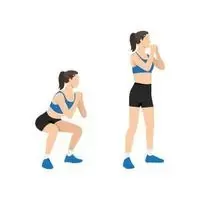
Wall squat
- How to do:
- To perform this exercise, just stand on a wall support with your hands by your sides, your feet shoulder-width apart, and your toes slightly out.
- Touch the wall with the back.
- Engage your core muscles throughout this time.
- Bend your knees until your thighs parallel the floor while maintaining a basic squat position with your arms by your sides.
- For two to three seconds, hold.
- After that, lift yourself by your heels and return to where you were before.
- In the beginning, phase, repeat this 10–20 times, then progressively increase the number of repetitions.
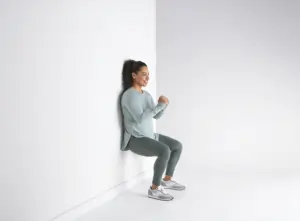
Prisoner squat
- How to do:
- Simply stand with your hands behind your head, feet shoulder-width apart, and toes slightly out to help support your shoulders and core muscles.
- You must now bend both knees and flex at the hips to sit back as though you were sitting down after standing.
- Keep your back straight.
- After that, lift yourself by your heels and go back to where you were before. In the initial phase, repeat this for 10 to 15 repetitions, then progressively increase the number of repetitions.
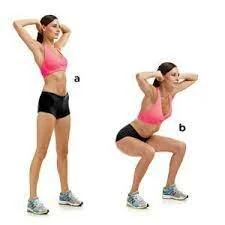
Side squatting exercise
- Your outer thigh muscles will get stronger with this exercise. Exercise in all planes—front, back, and side to side—is crucial.
- How to do:
- You now have to extend your left leg, bend both knees, shift your weight to your right side, and sit back on your right side.
- Raise your arms in front of you as if you were sitting down after standing.
- Keep your back straight. Hold for two seconds, then push yourself up by your heels to get back to where you were before.
- Start with 10 to 15 repetitions of this exercise, then progressively increase the number of repetitions. Similarly, repeat with the left leg. With additional repetitions, you can also perform this exercise with the other leg.
Pistol squat
- Try this squatting variant if you want to make this workout more challenging.
- This single-leg bodyweight exercise calls for flexibility, strength, and balance.
- How to do:
- Begin with your arms by your sides, feet shoulder-width apart, and toes slightly out.
- Next, drop your left leg till it is parallel to the floor while squatting on it.
- Get up and repeat this motion with a different leg. Perform 20 to 25 single-leg repetitions.
Single-leg squat
- This is the perfect single-leg strengthening exercise. Sportsmen and athletes benefit from it as well.
- You must squat with just one leg throughout this workout.
- You must stand on your right leg with your foot facing directly ahead for this exercise.
- To keep your trunk straight and your equilibrium intact, both of your arms should be straight and extended.
- The ball of your right foot bears your entire weight. Your left leg should be flexed 90 degrees.
- Lower your body now. Make an effort to get the floor closer. Return to the beginning position after pushing up by your heels.
- Repeat for a second leg. Perform three sets of ten to fifteen squats on each leg.
- You will not be mistaken for a single person or a pistol.
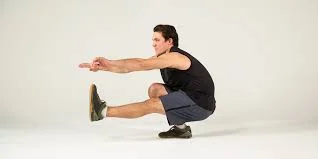
Plié squat
- Your inner thigh muscles will benefit greatly from this exercise.
- How to proceed:
- You must stand with your feet wider than shoulder width and your toes pointing out for this type of squat. Both of your feet should be on your side, rotating on the outside.
- To get your thighs parallel to the floor, sit down and bend both knees.
- Throughout the exercise, try to maintain an upright posture.
- Return to the beginning posture after pushing up by your heels.
- Start with 10 to 15 repetitions of this exercise, then progressively increase the number of repetitions.
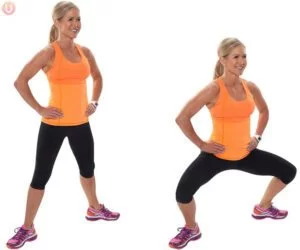
Plié squat with foot drag
- How to do:
- You must stand with your feet wider than shoulder width and your toes pointing out for this type of squat.
- Both feet should be by your side and rotate on the outside. Bending both knees will bring your thighs parallel to the floor.
- Try to maintain an upright posture throughout the exercise, similar to a sit-down position.
- Drag your right foot to meet your left foot after pressing up with your heels.
- Now perform the pile squat once again while standing with your left foot dragging toward your right.
- Perform this 20–25 times in a single session.
Squat with knee drive
- How to do:
- First, you must perform a simple squat by pushing your left leg as high as you can toward your chest while standing.
- Put it down again right away, execute a basic squat, then stand up and drive your right knee.
- Perform ten to fifteen repetitions in three sets.
Side-kick squat
- How to do:
- To achieve this, perform a simple squat first, then kick your left leg as high as you can as you return to standing.
- Remove right away, then perform a simple squat while returning to your upright posture by kicking your right leg as high as you can.
- On each leg, do this fifteen times.
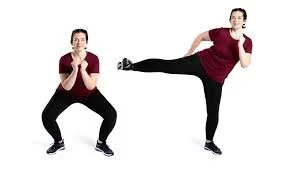
Split squat
- How to do:
- Prioritize your right foot over your left.
- To execute a basic squat, place your right leg in front of you and lower until your right thigh is parallel to the floor.
- Return to the beginning posture after pushing up by your heels.
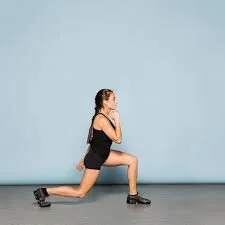
Close-stance squat
- Another name for this is a narrow squat.
- How to proceed:
- You just need to stand with your hands down by your sides, your foot and shoulder closer together, and your toes slightly out for this exercise.
- You now need to raise your arms in front of you, hinge at the hip, bend both knees and sit back as though you were sitting down after standing.
- Maintain a straight back.
- After that, lift yourself by your heels and return to where you were before.
- Start with 10 to 15 repetitions of this exercise, then progressively increase the number of repetitions.
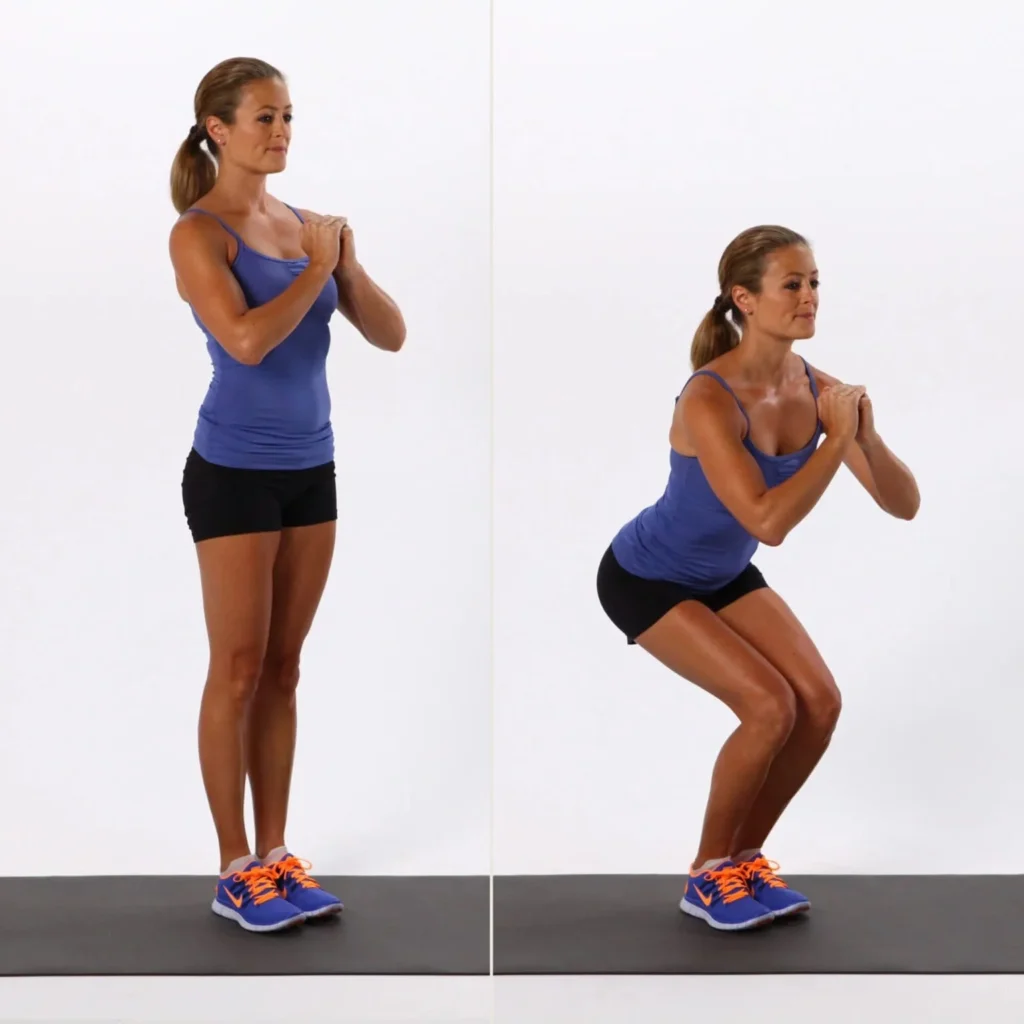
Lateral squat walk
- How to do:
- To do this exercise, stand with your feet shoulder-width apart, hands by your sides, and toes slightly out.
- You must now sit back on your right side, shift your weight to your right side, hinge at the hips, and bend both knees.
- Continue to move in a squat position on your right side for 15 steps, then move to your left side in the same manner.
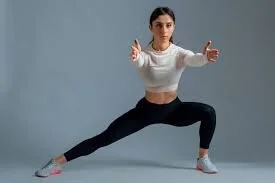
Curtsy squat
- How to do:
- For this workout, all you have to do is stand with your feet shoulder-width apart, your hands down at your hips, and your toes slightly out.
- Bend your left knee so that your thigh is parallel to the floor, then bring your right leg back and cross it behind your left leg to form a curtsy.
- Put yourself back on your feet and repeat with the second leg.
Squat walk
- This is an engaging workout that you may do every day.
- How to proceed:
- As you perform this exercise, maintain your hands by your sides and place your feet shoulder-width apart with your toes slightly out.
- You now need to raise your arms in front of you, hinge at the hip, bend both knees and sit back as though you were sitting down after standing.
- Maintain a straight back.
- You must walk in a basic squat position, one foot in front of the other, without getting up.
Frog squats
- How to do:
- You must first perform a simple squat by holding both hands together and placing both elbows inside your knees.
- Raise your buttocks in the air and then repeatedly bring them back down. Repeat 8–10 times.
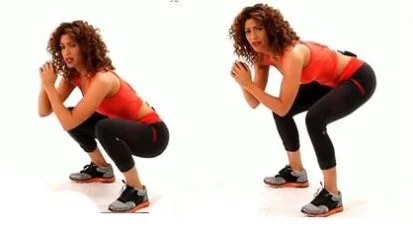
Squat pulse
- How to do
- You must first do the fundamental squat position.
- After doing the basic squat, you must stand with your back extended; instead, you must squat halfway and then drop back down.
- You must first perform ten repetitions before progressively increasing it.
Squat with kickback
- How to do:
- First, perform the basic squat position. Then, raise your left foot off the ground as you emerge from the squat.
- Tensing your glutes, kick your leg back behind you.
- Return your foot to the ground, squat again, and kick your right foot.
Overhead squat
- How to do:
- Compared to a basic squat, this exercise requires more stability and flexibility.
- Standing with your feet closer than shoulder width apart and toes pointed out.
- With a wide grasp, push over your head while holding a barbell or ball.
- Keep your head and chest straight, sit back into your hips, and bend both knees until your thighs are parallel to the floor.
- After two seconds of holding, lift yourself up by your heels and go back to where you were before.
- Repeat this for ten to fifteen repetitions during the initial phase.

Landmine squat
- How to do:
- You will need a landmine machine for this workout, which is typically found at gyms or fitness centers.
- Place the bar in a corner after adding a comfortable weight to it. Then, you must stand in front of the weighted end and grip it with both hands at chest height. You must then squat while holding the weight.
- Hold for two seconds with your thighs parallel to the floor, then push up with your heels to get back to the beginning position.
- Start with 10 to 15 repetitions of this exercise, then progressively increase the number of repetitions.
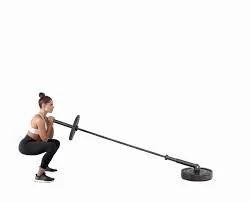
Barbell back squats
- You will need a barbell for this exercise. Place a barbell on each shoulder.
- You now need to perform a barbell squat workout.
- Hold for two seconds with your thighs parallel to the floor, then push up with your heels to get back to the beginning position.
- Start with 10 to 15 repetitions of this exercise, then progressively increase the number of repetitions.
Dumbbell squat
- Stand with your toes pointed out and your feet wider than shoulder-width apart.
- Maintain a firm grasp on a dumbbell by your side.
- Keep your head and chest straight, sit back into your hips, and bend both knees until your thighs are parallel to the floor.
- After two seconds of holding, lift yourself up by your heels and go back to where you were before.
- In the beginning phase, repeat this 10 to 15 times, then increase the number of repetitions.
Front squat
- How to do:
- You just need to stand with your feet wide apart, both arms folded across your chest, your toes slightly out, and your hands by your sides for this exercise.
- You now need to raise your arms in front of you, hinge at the hip, bend both knees and sit back as though you were sitting down after standing. Keep your back straight.Y our thighs are in line with the ground.
- After two seconds of holding, lift yourself up by your heels and go back to where you were before.
- Start with 10 to 15 repetitions of this exercise, then progressively increase the number of repetitions.
Goblet squat
- Simply stand with your feet wide apart, grasp a dumbbell or kettlebell in each hand, near to your chest, toes slightly out, and hands down by your sides for this workout.
- You now need to raise your arms in front of you, hinge at the hip, bend both knees, and sit back as though you were sitting down after standing.
- Keep your back straight.
- Hold for two seconds with your thighs parallel to the floor, then push up with your heels to get back to the beginning position.
- Start with 10 to 15 repetitions of this exercise, then progressively increase the number of repetitions.
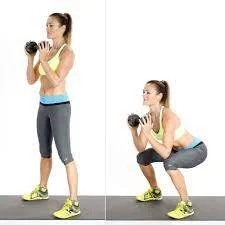
Zercher squat
- How to do;
- You must simply stand with your feet wide apart and the barbell resting on both elbows and knees in line with your toes while maintaining your lumbar curvature. Then, you must hinge at the hip and bend both knees, sitting back as though you were doing a sit-down posture from standing.
- Put your arms up in front of you. Maintain a straight back.
- Hold for two seconds with your thighs parallel to the floor, then push up with your heels to get back to the beginning position.
- Start with 10 to 15 repetitions of this exercise, then progressively increase the number of repetitions.
Bulgarian split squat
- A table or bench is needed for this one-leg squat exercise.
- This requires a strong core because you must hold a dumbbell or barbell on your back with both hands.
- You must place your right foot on a bench while standing in a split stance phase in front of a bench.
- You can stoop down without your knee collapsing over your toes if you extend your left foot far enough.
- With your left leg bent, perform a squat while maintaining an open chest. Hold for two seconds.
- After that, push up by your heels and go back to the beginning posture. Repeat on the other side.
Jump squatting exercise
- How to do:
- You must perform the fundamental squat position. lower down, then ascend through your toes into a jumping position.
- Quickly lower yourself into a squat position, then jump once more.
- In the beginning phase, perform this repeatedly for 10 to 15 repetitions, then progressively increase the number of repetitions.
Jump squat on toes
- How to do:
- Similar to a jump squat, this variation requires you to just raise your toes rather than leave the floor.
- Perform a simple squat and stand up on both feet.
- In the beginning phase, perform this repeatedly for 10 to 15 repetitions, then progressively increase the number of repetitions.
Weighted jump squat
- How to do:
- You must perform a basic squat while holding a dumbbell in each hand.
- Lower yourself, then as you rise, spring up through your toes.
- Quickly lower yourself into a squat position, then jump once more. Perform this repeatedly for 10 to 15 repetitions in the beginning, then progressively increase the number of repetitions.
Pop squat
- How to do:
- You just need to stand with your feet together, toes slightly out, and hands by your sides for this workout.
- Bend your elbows now. You must jump and take your foot in right away after popping up putting it out and bending your knees slightly.
- Bend your knees, stand up, then pop up again.
- In the initial phase, perform this repeatedly for 10 to 15 repetitions, then progressively increase the number of repetitions.
Squatting by using equipment like
Yoga balls, bands, benches, and boxes can all help you refine your workout while providing you with more challenges and resistance to increase your strength.
Wall squat on the yoga ball
- This activity requires an exercise ball.
- How to proceed:
- This workout involves standing close to a wall, placing an exercise ball between you and the wall, keeping your feet shoulder-width apart, your toes slightly out, and your hands by your sides.
- You now need to raise your arms in front of you, hinge at the hip, bend both knees and sit back as though you were sitting down after standing.
- You slide down the ball as you go into a squat.
- Keep your back straight.
- After that, lift yourself by your heels and return to where you were before.
- Start with 10 to 15 repetitions of this exercise, then progressively increase the number of repetitions.
Box or bench squat
- A box or bench squat is an excellent method for beginners to perform a squat if this is your first time.
- How to proceed:
- You must sit down and gently touch the box while standing in front of a bench.
- All you have to do is stand with your feet shoulder-width apart, your toes slightly out, and your hands by your sides.
- You now need to raise your arms in front of you, hinge at the hip, bend both knees and sit back as though you were sitting down after standing.
- Keep your back straight. Just softly touch your buttocks to the bench while keeping your thighs parallel to the floor, then hold the position for two seconds.
- After that, lift yourself by your heels and return to where you were before. In the initial phase, repeat this for 10 to 15 repetitions, then progressively increase the number of repetitions.
Mini band squat
- How to do:
- You will need a theraband or small band for this activity.
- You must position the tiny band above your knees and then use it to perform a simple squat.
- Squatting is required to press your thigh against the mini bands.
- After five seconds of holding, lift yourself by your heels and return to where you were before.
- Start with 10 to 15 repetitions of this exercise, then progressively increase the number of repetitions.
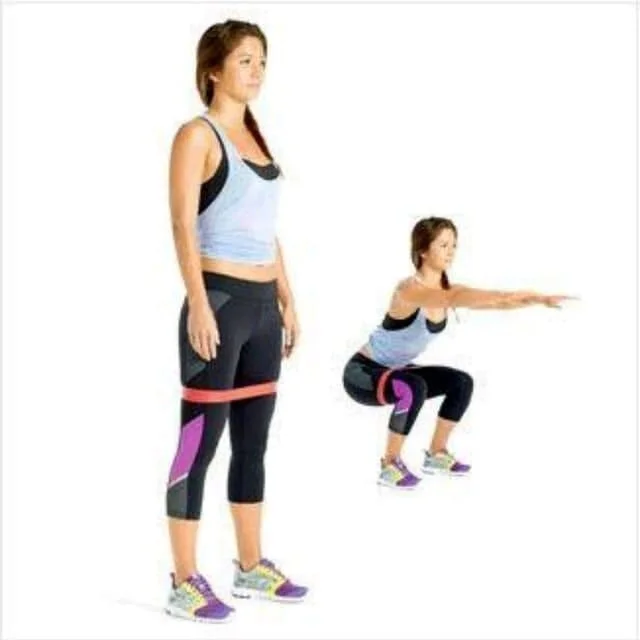
Sissy squatting exercise
- This variation can be performed with either a plate or a sissy squat machine.
- How to proceed:
- You must stand in a sissy squat machine with your foot beneath foot stop pads and your calf against the larger pad.
- To get both of your thighs parallel to the floor, you must push against the resistive band while sitting back.
- In the initial phase, stand up and repeat for 10 to 15 repetitions, then progressively increase the number of repetitions.
Resistance band squat
- Compared to dumbbells or other weight equipment, resistance bands are less taxing on your joints.
- A variety of colors are available for resistance bands.
- How to proceed:
- You must stand with both feet on resistance bands for this exercise.
- With your hand, hold the band at waist level. Maintaining your hands in the same posture, get up and perform a simple squat while gripping the band.
- Get back up and try again.
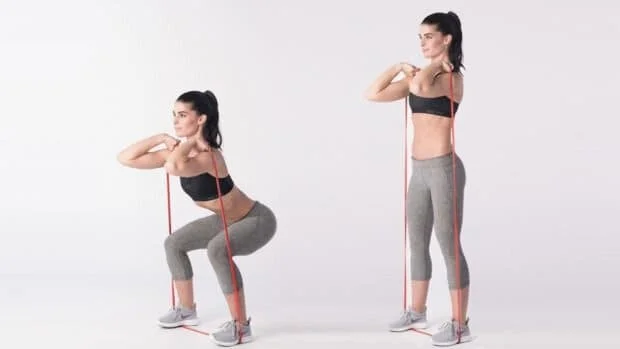
TRX squat
- How to do:
- TRX straps are required for this activity.
- Boost resistance by using your body weight and gravity.
- Stretch the TRX straps until they are taut by holding the handle in your hands at chest level with your arms outstretched.
- Pull simply against the TRX straps when squatting.
- In the initial phase, stand up and repeat for 10 to 15 repetitions, then progressively increase the number of repetitions.
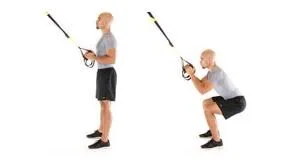
TRX squat kick
- How to do:
- You must first perform a simple TRX squat.
- Kick your left foot up and out as soon as it touches the floor when you stand up.
- You must start squatting right away.
- After that, get to your feet and kick your right leg out and up.
- Perform these exercises with alternating legs for 15–20 repetitions in three sets.
TRX squat jump
- How to do:
- You must first perform a simple TRX squat, and then you must leap.
- Then immediately return to a squat position by lowering yourself slowly.
- Perform these movements three times for fifteen repetitions.
TRX pistol squat
- How to do:
- This kind of squatting is more difficult than others, so you must grasp the TRX straps.
- Keep it at chest height. With your arms extended, stretch the strap until it is taut.
- Raise your right leg off the floor.
- While kneeling on your left leg, keep your right leg parallel to the floor.
- Stand up and perform a left-leg squat on the other leg.
Smith machine squat
- Another name for this workout is an aided squatting machine.
- It lowers the chance of injury while exercising.
- How to proceed:
- To do this, place a bar so that you can stand comfortably below it and load the machine with the appropriate amount of weight.
- It should lie on both of your shoulders and your traps.
- Bend both knees, sit back into your hips, and hinge at the hips to bring both thighs parallel to the floor.
- Get up and do it again.
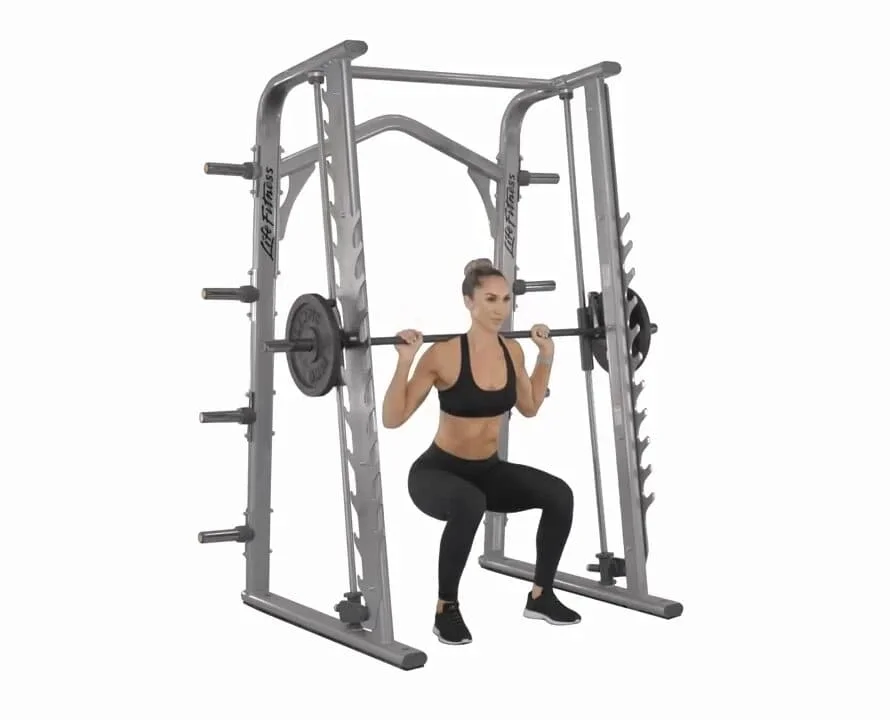
Hack squatting exercise
- We employ a different kind of machine, such as a hack machine, in this variation.
- How to proceed:
- For this workout, place your shoulder and trunk against the pads and load the machine with the desired amount of weight.
- Breathe deeply, release the safety grips, and bend your knees to a 90-degree angle.
- After that, straighten your legs back to the beginning position by pushing up through your feet.
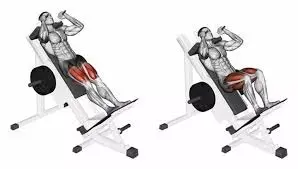
Bosu squat
- You will need a bosu ball for this activity. You can improve your balance when squatting by doing this workout.
- How to proceed:
- You have to stand with your feet shoulder-width apart on a bosu ball.
- Stretch both arms in front of you and bend both knees until your thighs are parallel to the ground.
- Keep your balance while sitting back on your hips.
- Throughout the workout, try to keep your trunk straight.
- In the initial phase, stand up and repeat for 10 to 15 repetitions, then progressively increase the number of repetitions.
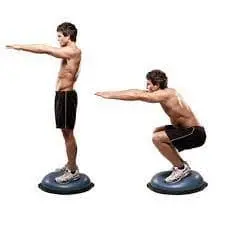
Reverse Bosu squatting exercise
- You must turn the bosu ball over for this workout, which makes it more difficult than standard bosu squats.
- How to proceed:
- It is facing up on this level surface. Take care when climbing on a bosu ball.
- You must now perform squats.
- Your head is up, your knee pushes outward, and your chest and trunk are straight.
- Return to the beginning position and repeat for three sets of fifteen repetitions.
Box jump to squat
- This variation uses a box and is an advanced plyometric movement. Take caution if this is your first time.
- How to proceed:
- A box must be in front of you. You must perform fundamental squats and
- Leap over the box and then lower yourself into a squat.
- Start with 10 to 15 repetitions, then progressively increase the number of repetitions.
You should never perform squats for the following reasons.
- back injuries. Squatting should be avoided by people who have back issues.
- weak knees.
- Squats may cause knee pain for certain people.
- peculiar physical attributes.
- We weren’t all made to squat.
- Other Options Could Be Better
- Machines Could Work More Effectively
- tense hip
- weak hip
- The strain on the muscles
- Hip impingement
Common mistakes happen during squats
You should avoid it
- Don’t skip the warm-up.
- Instead of starting at the knee joint, start from the hip joint.
- Don’t let your knees cross your toes.
- Never perform a half-hearted squat; always perform a full one.
- Do not wink.
- Avoid being fixated on your toes.
- Here, the maxim “always exhale on exertion” is not applicable.
“Bad” squats…
- Don’t use the proper muscles.
- At the right level of intensity
- Increase stress on your ligaments and joints.
- Increase your chance of suffering a joint injury
FAQs
What exercise are squats good for?
A good exercise for building muscle in the legs and back is the squat. Additionally, it can strengthen the core. It takes repetition to learn the right form for the activity, which lowers the chance of damage. Squats come in a variety of forms, each with unique advantages.
What do squats do to your body?
Squats improve balance and mobility.
They strengthen your legs, but they also strengthen your core and stabilizer muscles. By enhancing the communication between your brain and your muscle groups, these muscles help you stay balanced and reduce the risk of falling.
Do squats burn belly fat?
Squats do not specifically target belly fat, but they do build the obliques and abdominals, which stabilize your body during the exercise. Along with burning calories, they also help reduce body fat, including belly fat, when combined with a good diet and calorie deficit.
How many squats per day?
Ebenezer Samuel, C.S.C.S., fitness director at Men’s Health, says, “The exercise puts you in deep knee flexion and helps challenge [and increase] hip mobility.” He adds that most people should be able to complete 30 to 40 repetitions per day, though they can likely complete all those repetitions in a row with good form.
References:
- Lindberg, S. (2023, May 26). 7 Benefits of Doing Squats and Variations to Try. Healthline. https://www.healthline.com/health/exercise-fitness/squats-benefits#What-benefits-can-you-get-from-squat-variations
- Rowden, A. (2021, March 31). What are the benefits of performing squats? https://www.medicalnewstoday.com/articles/benefits-of-squats#benefits
- WebMD Editorial Contributor. (2023b, July 18). Health Benefits of Squats. WebMD. https://www.webmd.com/fitness-exercise/health-benefits-of-squats
- Physiotherapist, N. P.-. (2024c, September 22). Squatting Exercise: Health Benefits, Variation, How to Do? – Mobile Physio. Mobile Physiotherapy Clinic. https://mobilephysiotherapyclinic.in/squatting-exercise-health-benefits-variation-how-to-do/

